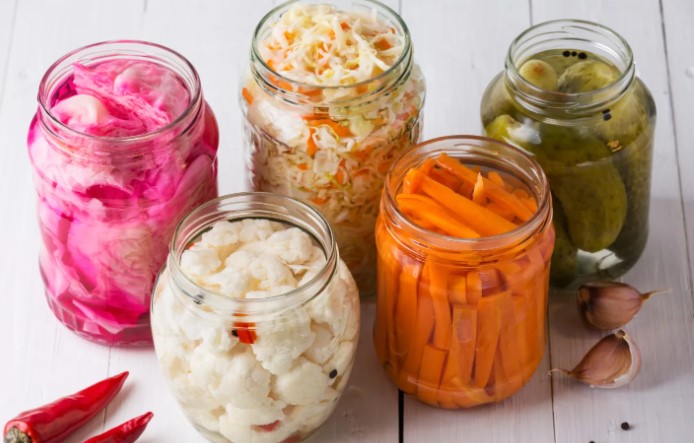9 Most Effective Prebiotic Foods
My Journey into the World of Prebiotics
When I first heard about prebiotics, I thought they were just another health fad. But after struggling with digestive issues, I started researching ways to support my gut health, and prebiotics kept popping up. These fiber-rich foods act like a nourishing meal for the good bacteria in our digestive system, helping them thrive. Think of prebiotics as a garden’s soil, creating a healthy foundation where beneficial bacteria (the “flowers”) can grow and flourish. Once I started incorporating prebiotic foods into my daily diet, I noticed the difference—better digestion, more energy, and even improved focus.
Now, I’m sharing my top nine prebiotic foods that transformed my gut health, hoping these will bring you the same relief and vitality.
1. Garlic: The Flavorful Gut-Booster
Garlic isn’t just a kitchen staple; it’s also one of the most powerful prebiotics out there. Garlic is rich in inulin, a type of fiber that serves as food for the healthy bacteria in your gut. It helps enhance the immune system and also has antimicrobial properties, which keep harmful bacteria at bay.
Personal Reflection: I always loved cooking with garlic, but once I learned about its prebiotic benefits, I started adding it to more meals. The boost to my digestion was almost immediate—like an internal “clean-up” that left me feeling lighter and more energetic.
How to Use It: Add fresh garlic to soups, sauces, stir-fries, and salad dressings. A clove or two daily can provide excellent prebiotic benefits.
2. Onions: A Gentle Gut Soother
Onions contain both inulin and fructooligosaccharides (FOS), which stimulate beneficial bacteria in the gut. FOS, in particular, has been shown to help improve the digestive system’s balance. Onions also add a comforting depth to meals, which makes them easy to incorporate daily.
Personal Reflection: I found that incorporating raw onions in salads or cooking them lightly in meals helped my digestion. They became a “go-to” in my recipes, making me feel more balanced and reducing occasional bloating.
How to Use It: Enjoy onions raw in salads, roasted with veggies, or added to savory dishes. Both cooked and raw onions are beneficial, but raw retains more prebiotic power.
3. Bananas: Nature’s Sweet, Fiber-Rich Snack
Bananas, especially when slightly underripe, contain prebiotic fibers that promote the growth of good bacteria in the gut. Bananas are gentle on the digestive system, making them an ideal prebiotic for anyone with sensitive digestion.
Personal Reflection: Adding a banana to my morning smoothie made a difference I could feel. It’s like my gut was saying, “Thank you for this simple, soothing fuel.” The mild sweetness and fiber helped ease my digestion, especially when I felt off-balance.
How to Use It: Eat bananas on their own, blend into smoothies, or slice over oatmeal for a natural, sweet prebiotic boost.
4. Apples: Crisp, Refreshing, and Gut-Friendly
Apples are high in pectin, a type of fiber that acts as a prebiotic. This fiber not only supports good bacteria but also helps improve digestion and regulate bowel movements. An apple a day truly does keep digestive discomfort away.
Personal Reflection: I started eating apples daily, and it was like my gut got a little extra support each day. The fiber kept things moving smoothly, and I felt more consistent in my digestion. Now, an apple is my afternoon pick-me-up.
How to Use It: Enjoy apples as a snack, in salads, or baked for a warming treat. Leave the skin on, as it contains a good portion of the prebiotic fiber.
5. Asparagus: A Powerhouse Veggie for Your Gut
Asparagus is another excellent source of inulin, making it a powerful prebiotic food. Inulin feeds the gut bacteria and has also been shown to help reduce bloating and support a healthy digestive system.
Personal Reflection: At first, I wasn’t thrilled about eating more asparagus, but once I tried it roasted with a bit of olive oil and salt, it quickly became a favorite. My digestion felt smoother, and the mild, earthy flavor was a bonus.
How to Use It: Grill, roast, or steam asparagus as a side dish, or add it to salads and pasta. Aim for a few spears a few times a week for maximum benefits.
6. Leeks: The Mild, Nutrient-Rich Prebiotic
Leeks are related to onions and garlic and pack a similar prebiotic punch. They’re high in inulin and help promote the growth of good bacteria, which is essential for maintaining gut health.
Personal Reflection: Leeks became a game-changer for me in soups. They add a mild, slightly sweet flavor that blends well, and my stomach always feels more settled after a meal with leeks. They’re my “secret ingredient” for gut-friendly meals.
How to Use It: Add leeks to soups, stews, or sautés. They pair beautifully with other vegetables and provide a comforting flavor that’s gentle on digestion.
7. Chicory Root: The Prebiotic Superstar
Chicory root is one of the richest sources of inulin, making it a top choice for gut health. It has a slightly bitter taste, which may take some getting used to, but its benefits make it worth it. Some people even use roasted chicory as a coffee substitute.
Personal Reflection: I was hesitant to try chicory root at first, but mixing it with my morning coffee added a unique flavor and seemed to support my digestion throughout the day. I felt more energized and balanced.
How to Use It: Try roasted chicory root as a coffee substitute or mix a little into your morning brew. Chicory is also available as an herbal tea for a gentle, gut-friendly option.
8. Dandelion Greens: Bitters with Benefits
Dandelion greens are not only a rich source of fiber but also contain prebiotics that support the growth of healthy gut bacteria. They may be slightly bitter, but they are a great addition to salads or can be blended into smoothies.
Personal Reflection: I was skeptical about the taste at first, but dandelion greens quickly grew on me. The bitterness seemed to balance out my digestion, and I felt less bloated after meals. It’s like a little “digestive reset” every time I eat them.
How to Use It: Add dandelion greens to salads, soups, or smoothies. Their bitterness pairs well with sweet and savory flavors.
9. Jerusalem Artichoke: The Gut-Supporting Root
Known as “sunchokes,” Jerusalem artichokes are high in inulin, making them excellent for promoting gut health. These knobby roots have a mild, nutty flavor and are easy to incorporate into meals.
Personal Reflection: I tried roasting Jerusalem artichokes with a bit of olive oil, and the taste was surprisingly delightful. My digestion seemed to improve after just a few meals with them, like my gut was getting the exact kind of fuel it needed.
How to Use It: Roast, sauté, or add Jerusalem artichokes to stews for a delicious, fiber-rich addition. They’re versatile and pack a powerful prebiotic punch.
Bringing Prebiotics Into Your Daily Life
Incorporating prebiotic foods into my diet was one of the best things I did for my gut health. Each of these foods brings its own unique benefits and adds variety to your meals, making gut health feel like less of a chore and more of a flavorful journey. Whether it’s the crunch of an apple, the savory warmth of garlic, or the slightly bitter bite of dandelion greens, these foods create a foundation for a healthy, balanced digestive system.
If you’re new to prebiotics, start by adding one or two of these foods to your daily meals. With time, you’ll likely notice a difference—not just in your digestion but in your overall energy, clarity, and well-being. Here’s to the power of prebiotics and nourishing our bodies from the inside out.


